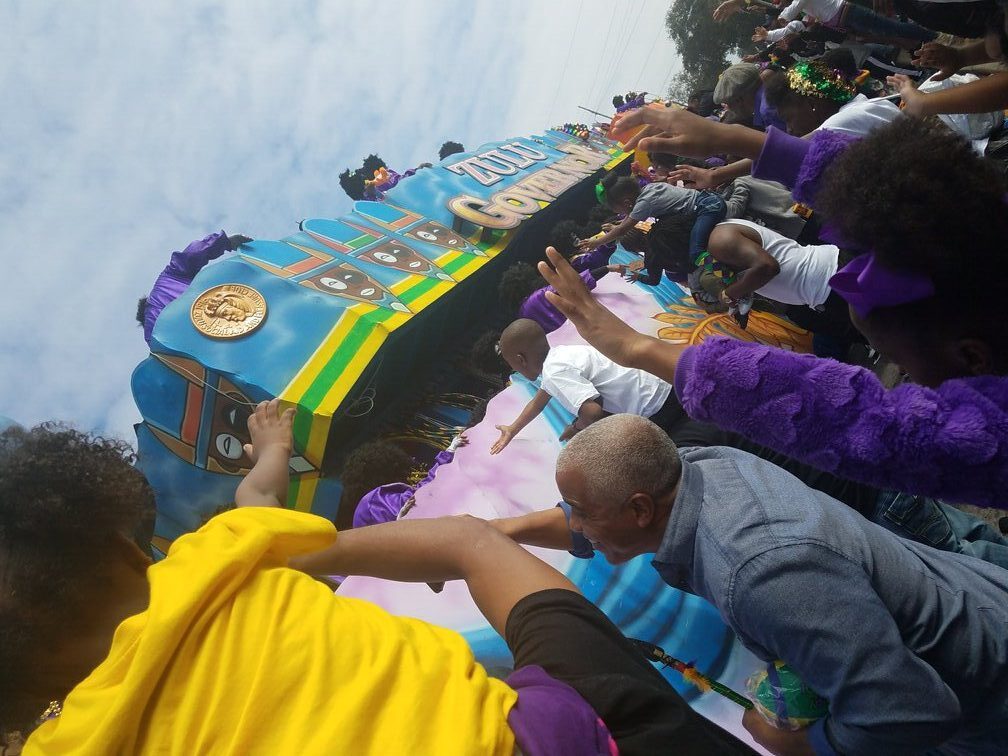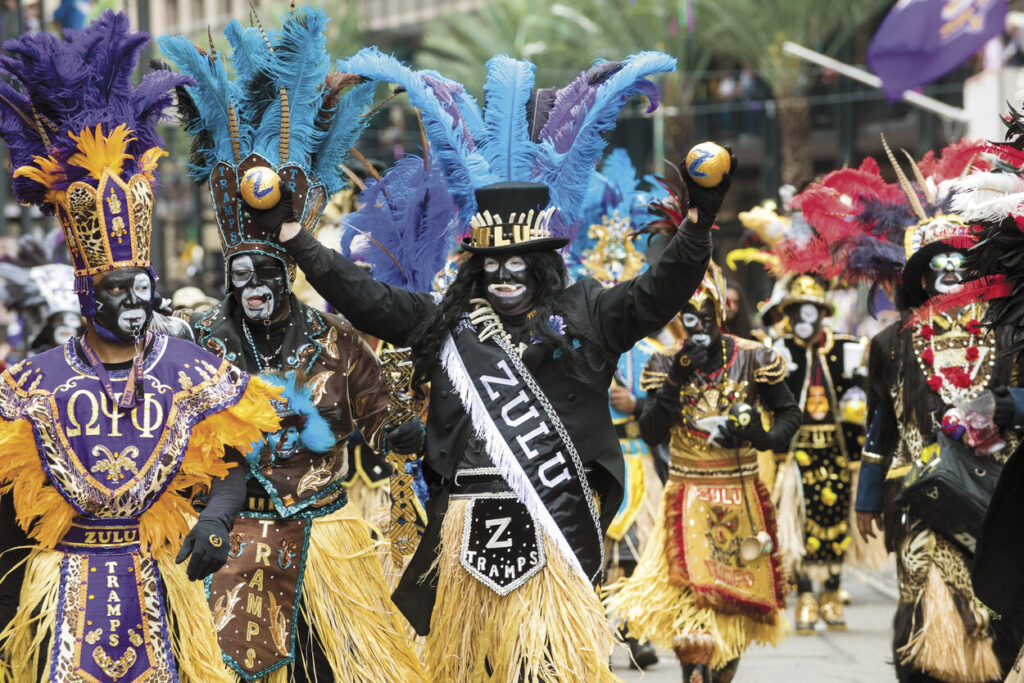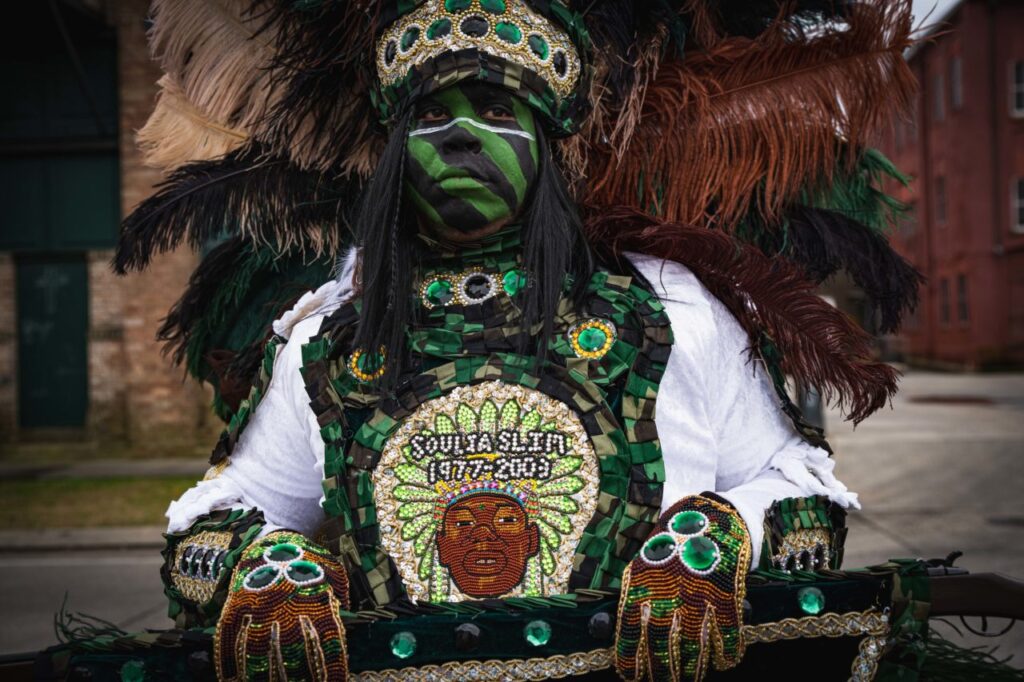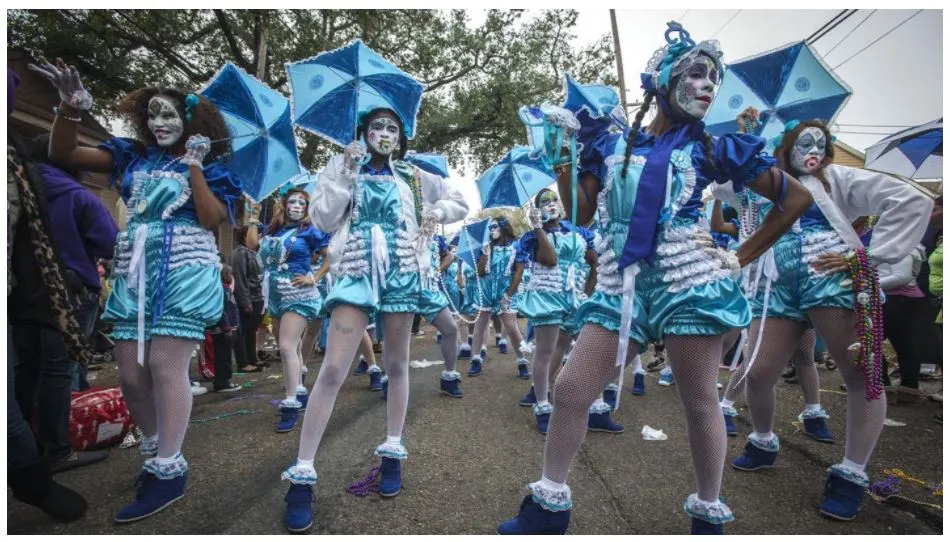The Black History of New Orleans Mardi Gras

Many folk outside of New Orleans hear Mardi Gras and think beads, booze, and boobs. While that’s one side of it, there’s so many sides to the festive holiday that became famous in New Orleans. One of those Mardi Gras sides includes a for-us-by-us version: a Black Mardi Gras.
Let’s start with the first misconception about Mardi Gras—that you have to show something to get something, beads in particular. That’s a Bourbon Street phenomenon that goes on all through the year as well as during Mardi Gras. That’s where the tourists hang out. But anyone who’s participated outside of Bourbon Street knows that beads are everywhere. Everyone is going home with beads and the street sweepers are pushing even more away the next day. Furthermore, beads are the least prized Mardi Gras “throw.” Why break your neck for beads, when you could go for a hand-painted umbrella, purse, shoe, or coconut?

Another misconception is that Mardi Gras is a parade. It’s actually a day that translates to Fat Tuesday. The date changes every year like Easter, but Mardi Gras is always the Tuesday before Ash Wednesday, which is also the first day of Lent. Lent lasts for about six weeks and ends on Easter. Though it’s a Christian holiday like Easter and Ash Wednesday, Christians and non-Christians participate, fasting from that which means them no good—physically, spiritually, and mentally. One might ask, “What you giving up for Lent?” The response is probably “dranking,” fried food, or, these days, social media. Mardi Gras, or Fat Tuesday, is your chance to get it all out of your system before you start your fast.
Ash Wednesday, Lent, and Easter are primarily for the church. By far, most people celebrating Mardi Gras, however, ain’t bothering with none of those other holidays. They’re just having a good time. That’s why the overall theme of Mardi Gras is “Laissez les bons temps rouler,” meaning “let the good times roll.” And while Mardi Gras might be one day, Mardi Gras season is damn near a whole month. It’s bigger than Christmas in New Orleans. Banks and schools close. Restaurants too. It’s serious.
During Mardi Gras season, parades are happening in and around the city every single day for about two weeks, and every parade/krewe got its own style and signature throw. Krewes ain’t just the people who march in the parades. They’re social clubs that host events throughout the year. Every historically black New Orleans ward (comparable to a district or precinct) had a social club. These organizations also helped pay for proper funeral and burials for underprivileged folk in the neighborhood.
The Zulu Social Aid and Pleasure Club was the first African-American parading social club, formally created for black folk by black folk in 1909. During that time and for more than 80 years afterwards, most krewes were all-white and usually all-male. This especially went for the city’s most exclusive and elite krewes. Black krewes couldn’t even parade main streets like St. Charles Avenue. They had to take the back streets. Though colored purple, green, and gold—symbolizing justice, faith, and power—black and white played distinct roles on Fat Tuesday.
Until 19-freaking-92, New Orleans krewes could legally segregate by race. The Mystick Krewe of Comus, the city’s oldest continuous krewe, established before emancipation in 1856, barred black folk and women from participating. So intent on its all white-male rider status, Comus chose to sit the 1992 parades out rather than integrate. The same for the Krewe of Momus, a secret society which formed in 1857. Though black people couldn’t join all-white krewes or ride on their floats until after 1992, they could help with the flambeaus and horses, and attend the parade following the city’s desegregation in the late ‘50s, early ‘60s. Just because you could go, however, didn’t mean they had to throw you something. The white folk would leave the parades with bags of goods while the black folk beside and behind them went home with next to nothing. That’s a complaint that still echoes ‘til this day.
As black folk do, though, we launched multiple efforts in the name of justice. While some fought for integration, others worked diligently to create something beautiful and powerful of our own and, dare I say, better. That’s how Zulu came to be. You also have New Orleans Most Talked Of Club (NOMTOC), a black krewe that started in 1969. Both are something beautiful to see, so much so that, depending where you are on the parade route, it’s likely more white patrons than black.
The Mardi Gras Indians are another treat. Though black, they call themselves Indians to honor the local indigenous tribes who, once upon a time, helped enslaved black folk escape slavery. What’s particularly special about the Indians are their carefully handcrafted suits and crowns, costing plenty time and money.

The sewing and beadwork incorporated in Mardi Gras Indian suits is one of the finest examples of traditional black folk art in the United States, and the same one is never worn twice. Indians redesign a new suit every single year. According to Larry Bannock, President of the New Orleans Mardi Gras Indian Council, “Downtown Indians use sequins, feathers; Uptown Indians use beads, rhinestones, feathers. The only time Downtown and Uptown Indians come together is to parade on St. Joseph’s day.” Otherwise, they’re rivals. Back in the day, that rivaling would get violent. These days, however, donning elaborate suits weighing more than 100 pounds, when the chiefs meet during the parade, it’s more of a stare-down, as they silently judge who’s “prettier.”
And the Indians ain’t one big group; there are various tribes. You have the Mohawk Hunters, the Wild Magnolias, the Fi Yi Yi, Cherokee Nation, and more than 20 more. And, unlike the parading krewes, Mardi Gras Indians have their own ranking structure and their own parading style. Whereas krewes have kings, the Indians have chiefs. Krewes’ parading schedules are published weeks in advance. Indians, on the other hand, don’t have an advertised time and place. It’s up the chief to announce when he gets ready. The Treme’s Backstreet Cultural Museum is a wonderful place to visit for more history and artifacts of the Mardi Gras Indians.

Photo Credit: NPR, “The ‘Baby Dolls’ Of Mardi Gras,” 2013
The Baby Dolls, who made their first Mardi Gras appearance in 1912, are a treat too. Their history is definitely one for the books. In the days of Jim Crow, prostitution was legal for white New Orleans and illegal (but accepted) for black New Orleans. In 1912, a group of black sex workers heard that their white counterparts were dressing up for the parade. Not to be outdone, they decided to do it even better. Since their patrons affectionately called them “baby doll” and because having an actual doll baby in those days was such a rarity, let alone a black one, that’s the character they chose to bring to life.
The construction of I-10, beginning in 1969, cut through the Treme, America’s oldest black suburb, where Black Mardi Gras flourished prior to desegregation. That construction subtracted many jewels from Black New Orleans including the longest single strand of oak trees in the country, hundreds of black-owned homes and businesses, and long-standing traditions such as the Baby Dolls. Mardi Gras 2013, the Baby Dolls made a comeback, parading with the krewe of black and gold better known as the Zulu.
Gone are the days of being limited to back streets. We’re headlining. And more black krewes and even krewes of black women are increasingly being added to the roster, adding to the display of what black New Orleans culture was and is all about: revering our ancestors and ancestral allies by way of masking, movement, and music. It’s about building on the equally vibrant and complicated past to create new inclusive, attention-grabbing manifestations of justice, faith, and power.

